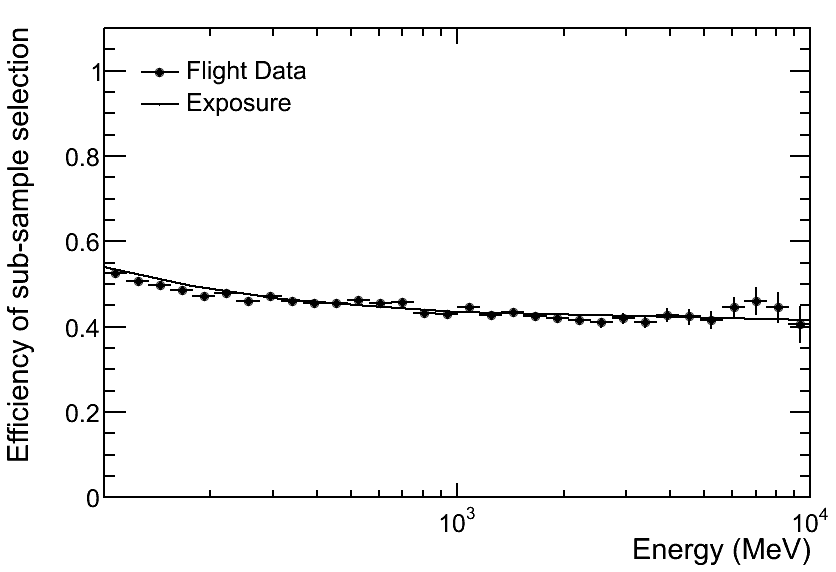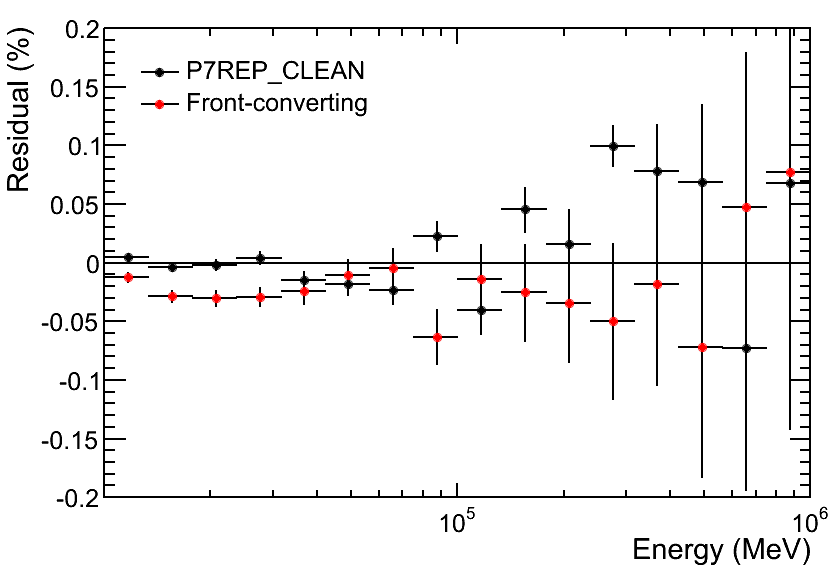Consistency checks as a means of estimating systematic biases
Following the procedure laid out in Sec.5.3.1 of Ackermann et al. (2012, ApJS 203, 4) the LAT team has tested the self-consistency of the P7REP_SOURCE_V15 IRFs to estimate the accuracy of the Monte Carlo simulations. Specifically, using control samples of data from the Vela pulsar and the Earth's Limb they split the P7REP_SOURCE dataset into a series of sub-samples, and, for each sub-sample, examined the fraction of the events in that sub-sample as a function of energy, and compared the flight data to the prediction given by the exposure calculation done using the IRFs.
Set of consistency checks performed
The LAT team has performed the various consistency checks listed below. Note that the on/off-axis and sides/corners checks are not possible with the Earth Limb sample as they require a point source in order to select the relevant time ranges when that source is a particular location in the LAT reference frame.
| Sub-sample(s) | Selection Criteria | Notes |
| P7REP_CLEAN | evclass=3 with gtselect | |
| Front/Back-Converting | convtype=1 (0 for back) with gtselect | |
| On/Off Axis | angsep(RA_SCZ,DEC_SCZ,<RA>,<RA>) < 45.572996 with gtmktime | Selects time ranges when the cosine between the source and the LAT boresight was > 0.7 <RA> and <DEC> are the celestial coordinates of the test source. |
| Sides/Corners | abs((( arctan2( sqrt(1. -( cos(#DEG * angsep(RA_SCX,DEC_SCX,<RA>,<RA>)))^2 - ( cos(#DEG * ANG(RA_SCZ,DEC_SCZ,<RA>,<RA>) ))^2 ), cos(#DEC * angsep(RA_SCX,DEC_SCX,<RA>,<RA>)))/#DEG) % 90) - 45.)/45. < 0.5 with gtmktime |
Selects time ranges when the "folded" phi of the test source is < 0.5; i.e., when the source was toward the sides of the LAT (rather than toward the corners). <RA> and <DEC> are the celestial coordinates of the test source. |
| Low/High} Cosmic Ray Background | LIVETIME / (STOP - START) > 0.907000 with gmktime | Selects time ranges fraction of live time (i.e., when the instrument wasn't busy reading out events) is larger than the median. High rates of incident cosmic rays cause lower livetime fractions. |
Results and Conclusions
For each of the sub-sample definitions listed above, the LAT team used the background subtraction technique from Sec.5.3.1. of Ackermann et al. (2012, ApJS 203, 4) to estimate the fraction of the gamma rays from the original sample that are present in the sub-sample as a function of energy. They compared this to the predictions obtained from the exposure calculation done using gtltcube and gtexpcube2. Here is an example showing the results for the front-converting sub-sample with the Vela pulsar control data.

They then looked at the distribution of residuals between the flight data and the predictions for all of the sub-samples listed above. Note that only one sub-sample from each pair is shown, as the residuals for the other sub-sample is simply the negative of the first.
| Vela pulsar control sample | Earth Limb control sample |
 |
 |
In summary, the LAT team finds that the P7REP_SOURCE_V15 IRFs are self-consistent to better than 2% from 100 MeV to 3 GeV, to better than 5% up to 100 GeV, and to better than 10% up to 1 TeV. Note, however, that these tests do not rule out any global biases that are uncorrelated with the various sub-selections that were tested, and that might have been introduced in earlier stages of the event trigger, reconstruction and selection algorithms.



